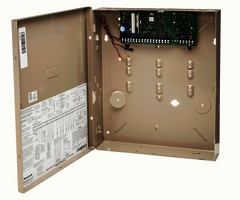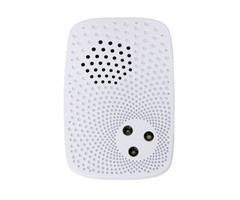Alarm Grid Video Recap: February 12th - 27th
Posted By Michael GorisHi DIYers! We're here with the latest video recap from Alarm Grid. Our team managed to put up 9 new videos during the past two weeks, and we are eager to share them with you. Take a look at these new videos, as Alarm Grid techs teach you how to get the most of your security system!
Programming the 5800Combo to a Vista Panel
Joe covers the process of enrolling a Honeywell 5800COMBO with a Honeywell VISTA Alarm System. In order for the sensor to work with the system, a 345 MHz wireless receiver must be added.The sensor will require five zones for full functionality. These zones are for smoke/heat detection, CO detection, low-temperature detection, maintenance, and end of product life. Each zone must be programmed individually. If you don't want to use a particular function, you can skip programming that zone.

Using the 2-Way Voice Feature with an Alarm.com Camera on the Qolsys IQ Panel 2
Joe demonstrates the audio streaming feature on the Qolsys IQ Panel 2 that is compatible with certain Alarm.com Cameras. The feature is available for Qolsys IQ Panel 2 Systems that are running firmware version 2.2.1 or higher. By using this feature, the user can have a live conversation with whoever is at their camera right from the IQ Panel 2. The option of "Audio for Non-Doorbell Cameras" must be enabled by the user's alarm monitoring provider. The panel and the Camera should be connected on the same WIFI network.
How Do I Setup Multi-System Account Access in Alarm.com?
Joe shows users the process of linking multiple Alarm.com accounts together. The benefit to do this is that the user will be able to control all their Alarm.com locations conveniently from a single login. This is great for users who operate security systems across multiple locations. The pairing process must be completed using the Alarm.com website. The user will need to provide the username and password for any account they want to pair when syncing the different Alarm.com accounts.
Upgrading the 2GIG GC3 to an LTE Communicator
Jorge completes the process of upgrading a 2GIG GC3 to use an LTE cellular communicator. An example of an LTE communicator for the 2GIG GC3 is the 2GIG LTEV1-A-GC3. When swapping out the old communicator, the user should make sure to power down their system first. Failing to do this could result in system damage. By upgrading to an LTE communicator, an end user will enjoy faster speeds and greater reliability. They will also extend the life of their system, as LTE is expected to remain in service well into the distant future.
Programming a New SiX Series Device Into an Older Lyric System
Jorge explains why some users might experience trouble when trying to program newer Honeywell SiX Series Sensors with an older Honeywell Lyric Alarm System. The problem occurs because the newest SiX Series Sensors have an updated MAC prefix that is not compatible with Lyric Systems that are not running at least firmware version MR7 or higher. Any customer who is monitored by Alarm Grid can have the latest firmware pushed down to their Lyric System. This is a free over-the-air firmware update.
Learning the DSC PG9929 Key FOB to the Qolsys IQ Panel 2 Plus
Jorge teaches users how to enroll a DSC PG9929 Key Fob to a Qolsys IQ Panel 2 Plus. The IQ Panel 2 Plus Systems have PowerG daughtercards that allow them to support the 915 MHz PowerG Sensors. However, these sensors enroll in a unique manner. The system should be in its auto-enrollment mode. The user must then press and hold the enrollment button, which is the star (*) button for the PG9929. The button should be held until an LED light appears for a second time. They can then release the button to enroll.
Learning the DSC PG9938 Panic Switch to the Qolsys IQ Panel 2 Plus
Jorge demonstrates the process of enrolling a DSC PG9938 Panic Switch to the Qolsys IQ Panel 2 Plus. The PG9938 is a personal panic switch that can be enrolled with the IQ2+ like any other PowerG Sensor. Pressing this button will trigger an immediate system panic. The device is perfect for elderly or disabled individuals who may need to call for hep in case of an accident or fall. It can also be used to trigger a panic alarm from virtually anywhere on the property. The button must be pressed and held, which helps to avoid false alarms.
Honeywell Thermostats and Total Connect 2.0 Compatibility
Joe tells users which thermostats will work with Total Connect 2.0. The simple answer is that Z-Wave thermostats from any manufacturer that can enroll with your Honeywell Alarm System, along with most Honeywell WIFI Thermostats can be operated through Total Connect 2.0. However, Z-Wave thermostats will offer greater functionality through TC2 than WIFI thermostats. This is because only Z-Wave thermostats can be used with TC2 Smart Scenes. But certain WIFI thermostats can be used with other platforms like Apple HomeKit.
Jarrett teaches users how to put the Honeywell Lyric Controller into Arm Stay mode. This is the arming mode to use if someone is going to remain inside the building. In Arm Stay mode, all interior zones are automatically bypassed. This way, the end user can move throughout the building without having to worry about setting off an alarm. However, entry/exit zones, perimeter zones and 24-hours zones will still respond as if the system was set to Arm Away.














 It's no secret that customer-oriented businesses and security cameras are the perfect match. A video surveillance system is great for catching theft and dishonest bait-and-switch tactics that a small number of dishonest people may try to get away with. But what you might not think of is using security cameras to protect your company in case of a lawsuit.
It's no secret that customer-oriented businesses and security cameras are the perfect match. A video surveillance system is great for catching theft and dishonest bait-and-switch tactics that a small number of dishonest people may try to get away with. But what you might not think of is using security cameras to protect your company in case of a lawsuit.




 The firmware update is version 3.2.1.6653. Although the changes it offers are relatively minor, it's still worth downloading for users who want to get the very most out of their GC3 Systems. The biggest change is the addition of the screensaver feature, which will also likely be referred to as the slideshow feature. Users can add personal photos to a USB drive and transfer them to their GC3 System or associated
The firmware update is version 3.2.1.6653. Although the changes it offers are relatively minor, it's still worth downloading for users who want to get the very most out of their GC3 Systems. The biggest change is the addition of the screensaver feature, which will also likely be referred to as the slideshow feature. Users can add personal photos to a USB drive and transfer them to their GC3 System or associated 